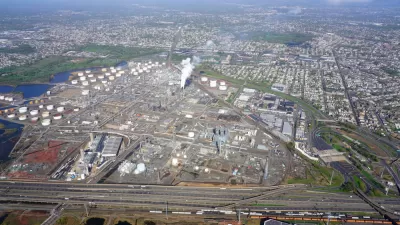How can President Trump, who has made environmental regulation rollbacks and climate denial trademarks of his administration, be expected to select projects for his infrastructure plan that must weather climate change?

The Trump infrastructure plan, expected to be unveiled Monday, hopes to leverage $200 billion to generate $1.5 trillion. In addition to achieving that financial feat, it must consider the outcome of selecting projects should, like the administration, they ignore climate science.
Unlike Trump and many in his cabinet who question the existence of global warming (or think that it is beneficial), infrastructure projects are expected to hold up to weather, which is changing due to climate change.
"The Trump infrastructure blueprint is almost certain to call for expensive new roads, bridges, airports and other projects in areas that are increasingly vulnerable to rising waters and other threats from a warming planet," reports Coral Davenport, who covers energy and environmental policy, with a focus on climate change, for The New York Times, on Feb. 10.
Engineers and researchers say that construction plans should consider these design constraints at the outset
“The impact of not considering climate change when planning infrastructure means you end up building the wrong thing, in the wrong place, to the wrong standards,” said Michael Kuby, a professor of geographical sciences and urban planning at Arizona State University and contributing author to the National Climate Assessment, the federal government’s most comprehensive scientific study of the effect of global warming on the United States. “That’s a whole lot of waste.”
Davenport reports that while U.S. Environmental Protection Agency Administrator Scott Pruitt may deny climate science, a report prepared by his agency last year for the Fourth National Climate Assessment "concluded that, through the end of the century, up to $280 billion will be needed to adapt the nation’s roads and railways to the effects of a warming climate."
It provides analysis showing that “proactive adaptation” — essentially, planning for global warming before you build — could save the government up to 70 percent in future costs of repairing damage caused by climate change-driven weather events such as deluges, coastal flooding and heat waves.
Davenport sites specific infrastructure projects which need to be designed for what the climate is expected to be like in 25 to 50 years.
“If you don’t do that,” said Paul Chinowsky, a professor of civil engineering at the University of Colorado, Boulder, “It could double the cost of maintenance and the amount of delays on that road.”
The situation is similar to planning the rebuilding efforts following Hurricane Harvey last August which occurred a mere two weeks after Trump signed an executive order that gutted "the Obama-era Federal Flood Risk Management Standard, which set higher resiliency standards for projects that receive federal funds and are vulnerable to sea-level rise," according to Planetizen.
Hat tip to Mark Boshnack.
FULL STORY: Trump’s Infrastructure Plan May Ignore Climate Change. It Could Be Costly

Trump Administration Could Effectively End Housing Voucher Program
Federal officials are eyeing major cuts to the Section 8 program that helps millions of low-income households pay rent.

Planetizen Federal Action Tracker
A weekly monitor of how Trump’s orders and actions are impacting planners and planning in America.

Ken Jennings Launches Transit Web Series
The Jeopardy champ wants you to ride public transit.

Rebuilding Smarter: How LA County Is Guiding Fire-Ravaged Communities Toward Resilience
Los Angeles County is leading a coordinated effort to help fire-impacted communities rebuild with resilience by providing recovery resources, promoting fire-wise design, and aligning reconstruction with broader sustainability and climate goals.

When Borders Blur: Regional Collaboration in Action
As regional challenges outgrow city boundaries, “When Borders Blur” explores how cross-jurisdictional collaboration can drive smarter, more resilient urban planning, sharing real-world lessons from thriving partnerships across North America.

Philadelphia Is Expanding its Network of Roundabouts
Roundabouts are widely shown to decrease traffic speed, reduce congestion, and improve efficiency.
Urban Design for Planners 1: Software Tools
This six-course series explores essential urban design concepts using open source software and equips planners with the tools they need to participate fully in the urban design process.
Planning for Universal Design
Learn the tools for implementing Universal Design in planning regulations.
Ada County Highway District
Clanton & Associates, Inc.
Jessamine County Fiscal Court
Institute for Housing and Urban Development Studies (IHS)
City of Grandview
Harvard GSD Executive Education
Toledo-Lucas County Plan Commissions
Salt Lake City
NYU Wagner Graduate School of Public Service





























